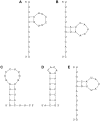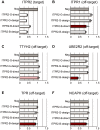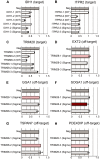Whole-genome thermodynamic analysis reduces siRNA off-target effects
- PMID: 23484018
- PMCID: PMC3590146
- DOI: 10.1371/journal.pone.0058326
Whole-genome thermodynamic analysis reduces siRNA off-target effects
Abstract
Small interfering RNAs (siRNAs) are important tools for knocking down targeted genes, and have been widely applied to biological and biomedical research. To design siRNAs, two important aspects must be considered: the potency in knocking down target genes and the off-target effect on any nontarget genes. Although many studies have produced useful tools to design potent siRNAs, off-target prevention has mostly been delegated to sequence-level alignment tools such as BLAST. We hypothesize that whole-genome thermodynamic analysis can identify potential off-targets with higher precision and help us avoid siRNAs that may have strong off-target effects. To validate this hypothesis, two siRNA sets were designed to target three human genes IDH1, ITPR2 and TRIM28. They were selected from the output of two popular siRNA design tools, siDirect and siDesign. Both siRNA design tools have incorporated sequence-level screening to avoid off-targets, thus their output is believed to be optimal. However, one of the sets we tested has off-target genes predicted by Picky, a whole-genome thermodynamic analysis tool. Picky can identify off-target genes that may hybridize to a siRNA within a user-specified melting temperature range. Our experiments validated that some off-target genes predicted by Picky can indeed be inhibited by siRNAs. Similar experiments were performed using commercially available siRNAs and a few off-target genes were also found to be inhibited as predicted by Picky. In summary, we demonstrate that whole-genome thermodynamic analysis can identify off-target genes that are missed in sequence-level screening. Because Picky prediction is deterministic according to thermodynamics, if a siRNA candidate has no Picky predicted off-targets, it is unlikely to cause off-target effects. Therefore, we recommend including Picky as an additional screening step in siRNA design.
Conflict of interest statement
Figures






Similar articles
-
Soft computing model for optimized siRNA design by identifying off target possibilities using artificial neural network model.Gene. 2015 May 15;562(2):152-8. doi: 10.1016/j.gene.2015.02.067. Epub 2015 Feb 25. Gene. 2015. PMID: 25725126
-
siDirect 2.0: updated software for designing functional siRNA with reduced seed-dependent off-target effect.BMC Bioinformatics. 2009 Nov 30;10:392. doi: 10.1186/1471-2105-10-392. BMC Bioinformatics. 2009. PMID: 19948054 Free PMC article.
-
Designing functional siRNA with reduced off-target effects.Methods Mol Biol. 2013;942:57-68. doi: 10.1007/978-1-62703-119-6_3. Methods Mol Biol. 2013. PMID: 23027045
-
Designing highly active siRNAs for therapeutic applications.FEBS J. 2010 Dec;277(23):4806-13. doi: 10.1111/j.1742-4658.2010.07903.x. FEBS J. 2010. PMID: 21078115 Free PMC article. Review.
-
Therapeutic potential of siRNA-mediated transcriptional gene silencing.Biotechniques. 2006 Apr;Suppl:7-13. doi: 10.2144/000112166. Biotechniques. 2006. PMID: 16629382 Review.
Cited by
-
Combinatorial RNA Interference Therapy Prevents Selection of Pre-existing HBV Variants in Human Liver Chimeric Mice.Sci Rep. 2015 Oct 20;5:15259. doi: 10.1038/srep15259. Sci Rep. 2015. PMID: 26482836 Free PMC article.
-
Protein kinase D1 deficiency promotes differentiation in epidermal keratinocytes.J Dermatol Sci. 2014 Dec;76(3):186-95. doi: 10.1016/j.jdermsci.2014.09.007. Epub 2014 Oct 2. J Dermatol Sci. 2014. PMID: 25450094 Free PMC article.
-
454-Pyrosequencing Analysis of Bacterial Communities from Autotrophic Nitrogen Removal Bioreactors Utilizing Universal Primers: Effect of Annealing Temperature.Biomed Res Int. 2015;2015:892013. doi: 10.1155/2015/892013. Epub 2015 Sep 3. Biomed Res Int. 2015. PMID: 26421306 Free PMC article.
-
Nanoparticles-assisted delivery of antiviral-siRNA as inhalable treatment for human respiratory viruses: A candidate approach against SARS-COV-2.Nano Sel. 2020 Dec;1(6):612-621. doi: 10.1002/nano.202000125. Epub 2020 Oct 12. Nano Sel. 2020. PMID: 34485978 Free PMC article. Review.
References
-
- Ghildiyal M, Zamore PD (2009) Small silencing RNAs: an expanding universe. Nat Rev Genet 10: 94–108 doi:10.1038/nrg2504. - DOI - PMC - PubMed
-
- Kim VN, Han J, Siomi MC (2009) Biogenesis of small RNAs in animals. Nat Rev Mol Cell Biol 10: 126–139 doi:10.1038/nrm2632. - DOI - PubMed
-
- Carthew RW, Sontheimer EJ (2009) Origins and Mechanisms of miRNAs and siRNAs. Cell 136: 642–655 doi:10.1016/j.cell.2009.01.035. - DOI - PMC - PubMed
-
- Hutvagner G, Simard MJ (2008) Argonaute proteins: key players in RNA silencing. Nat Rev Mol Cell Biol 9: 22–32 doi:10.1038/nrm2321. - DOI - PubMed
-
- Czech B, Hannon GJ (2011) Small RNA sorting: matchmaking for Argonautes. Nat Rev Genet 12: 19–31 doi:10.1038/nrg2916. - DOI - PMC - PubMed
Publication types
MeSH terms
Substances
LinkOut - more resources
Full Text Sources
Other Literature Sources
Research Materials
Miscellaneous

